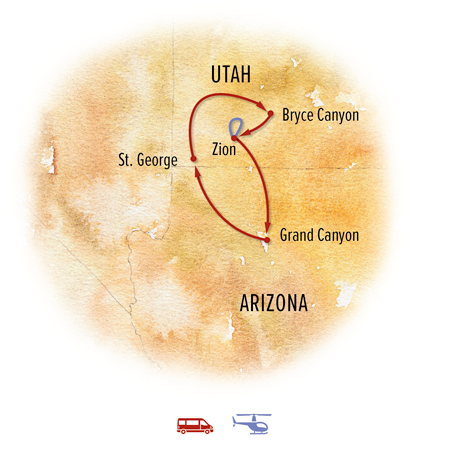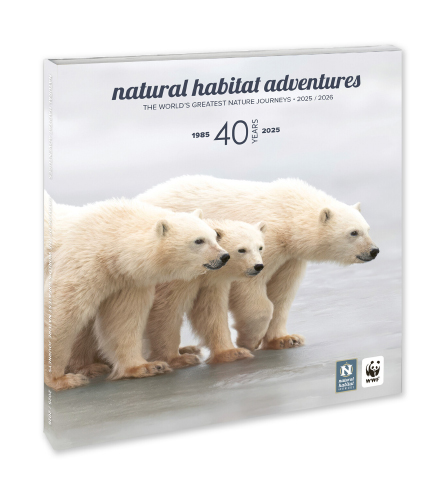Itinerary
Our canyonlands adventure begins in the red rock country of St. George, Utah. This evening we meet for a welcome dinner at a local restaurant. Our Expedition Leader offers a brief orientation to the history, geology, wildlife and ecology of the Colorado Plateau, which we explore in depth on our foray through three of the world's most magnificent national parks.
Day 2: Cedar Breaks National Monument / Bryce Canyon National Park—Dark Sky Experience
En route to Bryce Canyon, we stop at several scenic spots including Cedar Breaks National Monument. From the rim at 10,350 feet, gaze down into a half-mile-deep geological amphitheater of stacked orange layers, fins and pinnacles. Dynamic natural forces over millennia have exposed and sculpted this terraced terrain topped with ancient bristlecone pines and subalpine forest. Cedar Breaks crowns the Grand Staircase, which our itinerary follows throughout the trip as we descend this series of five sedimentary “steps” into ever older geological features, each characterized by a different color and biome over a time span of more than 200 million years.
Later this afternoon we reach Bryce Canyon. The national park was established in 1925 to protect and draw visitors to its fantastical landscape, which feels like a portal to another world. Its pink pinnacles, limestone formations and natural amphitheaters capture the imagination with geological surprises. Red rock walls are rent with deep channels while whimsical hoodoos—rock spires carved eons ago by erosion—rise hundreds of feet into the sky. Rising early to watch the sunrise and lingering over radiant sunsets, experience the ever-changing grandeur of this astounding landscape.
After dark, another wonder awaits: a chance for some of the best stargazing in North America. The night skies around Bryce are some of the darkest in the United States, thanks to the park’s high elevation above 8,000 feet, its remote location, and its clear, clean air. Joined by a park ranger, we head just outside the park bounds, away from any artificial light, to witness the night sky through telescopes. Offering an extraordinary view of the cosmos, Bryce holds International Dark Sky status, and the absence of light pollution reveals more than 7,500 stars on a clear night, while the Milky Way arcs in a luminous band across the dark tapestry overhead. During a new moon, the sight is otherworldly, as planets, constellations and distant galaxies seem close enough to touch.
Day 3: Hiking in Bryce Canyon National Park
Today we discover Bryce Canyon on foot, the only way to explore its intricate sedimentary depths at close range. Guided by our Expedition Leader, we drop below the rim on series of switchback trails that descend 550 feet into the lower canyon, where we find pinyon pines and junipers. Heading back up again, gain a different perspective on the forest of hoodoos as we weave among their unique shapes [Guests who don’t wish to tackle the elevation gain can walk the paved trails on the rim.] In the afternoon, more opportunities await to explore Bryce from different vantage points, including a panorama across the vast landscape of the natural amphitheater crowded with hoodoos.
Day 4: Bryce Canyon Sunrise / Zion National Park
Given our optimal location near the rim, it’s easy to rise early to watch the sunrise over Bryce Canyon. We witness a striking array of colors as the changing light illumines the stone pinnacles and sheer cliffs. A morning hike offers yet more angles on this wondrous landscape, more evocative with each turn in the trail.
Then it’s time to head for Zion National Park on one of the most scenic drives in the American Southwest. Keep an eye out for bighorn sheep as we follow the narrow two-lane road that cuts through canyons and twists below towering monoliths. As we approach Zion, we pass Checkerboard Mesa, a 6,250-foot landmark of striated Navajo Sandstone. Early Mormon pioneers gave Zion its name—so striking was its beauty that it evoked images of the biblical Promised Land. The U.S. government agreed and made it a national park in 1919. Multi-hued sandstone ramparts rise above the valley floor where the Virgin River flows among the cottonwoods, carving a deep canyon over millennia and blending lush greenery with dramatic rockscapes.
Day 5: Hiking in Zion National Park / Scenic Helicopter Flight
Begin the day exploring Zion Canyon on foot, following narrow trails below 2,000-foot cliffs of Navajo Sandstone that soar above us on either side. On the canyon floor, see lush and colorful hanging gardens growing out of the rock. Trails along the river lead to quiet recesses, where we may hear and see many birds unique to the American West. Listen for the haunting cry of canyon wrens, look to the skies overhead for golden eagles and prairie falcons, and find American dippers and phoebes in the willows along the riverbanks. Then climb higher for dramatic views of the towering canyon walls and shadowy depths below. Varied overlooks reveal different vantage points on Zion’s geological drama, as we witness the tremendous power of water and wind to sculpt this landscape.
A highlight of our visit is a helicopter flight in and around Zion National Park, featuring aerial views of Smith Mesa, Kolob Canyons and Red Butte Mountain, in addition to notable landmarks of the park itself.
Day 6: Morning Hike in Zion / Grand Canyon National Park—North Rim
Following a peaceful morning hike in Zion, we travel south to one of America’s most iconic national parks: Grand Canyon, established in 1919. Lying entirely within the state of Arizona, the park encompasses 278 miles of the Colorado River and adjacent plateau. Located on the ancestral homelands of 11 tribal communities that hold the space sacred, Grand Canyon is one of the most spectacular examples of erosion anywhere on Earth. Humans have lived in the Grand Canyon region for 25,000 years, a mere blip in time compared to the 1.7 billion-year-old Vishnu Schist rocks visible along the Colorado River in the bottom of the canyon.
The Grand Canyon’s popularity can mean many visitors, so we avoid the bulk of the crowds by concentrating on the less-visited but no less spectacular North Rim. It sees just 10% of the total number of visitors to the national park each year, most of whom stay on the far more developed South Rim. We spend two nights at Grand Canyon Lodge, tucked among the ponderosa pines at 8,000 feet on the canyon’s edge. The classic lodge, now a National Historic Landmark, is the only accommodation inside the park on the North Rim. Built in 1928 by architect Gilbert Stanley Underwood, the lodge on Bright Angel Point was constructed of native Kaibab limestone and heavy timber logs that capture the rustic national park style of the era. After a fire four years later, it was rebuilt in 1936, preserving the original stone, and that venerable structure endures today.
With two days here, there's plenty of time to explore and absorb the drama of one of the planet’s most magnificent natural landscapes, watching the variegated canyon walls change color as the light shifts throughout the day.
Day 7: Grand Canyon Sunrise / Hiking the North Rim
No western adventurer should miss gazing into the mile-deep chasm of the Grand Canyon in the ethereal light of sunrise and sunset, and it’s easy to do since from our coveted location right on the rim. Our Expedition Leader knows the best overlooks to capture the beauty of sunrise, including Cape Royal and Point Imperial, though really, any spot on the rim is going to offer a stunning experience. Sunset will likewise bring astonishment as we watch the canyon depths shift from orange and rust to pink and purple as the sinking sun casts its glow in contrast to with the shadows moving across the etched peaks and crevasses.
We spend the day on several hikes, tapping the deep knowledge of our Expedition Leader who knows the best trails and viewpoints for a more secluded encounter with this extraordinary geological phenomenon. Admire vistas from different viewpoints along the rim and just below, enjoying moments of relative solitude away from the crowds that frequent the opposite side. Tonight, we share a farewell dinner together at the lodge. Then, step out onto the stone terrace once night falls for a final chance to stargaze: Grand Canyon National Park was recognized as an International Dark Sky Park in 2019, after a three-year endeavor to protect its night skies by altering light fixtures and taking measures to reduce light pollution.
Day 8: Grand Canyon / St. George / Depart
Rise at dawn for a last sunrise over the North Rim before we depart after breakfast. Leaving the red rock wonders of the America’s canyon country behind, our Grand Canyon tour concludes as we travel back to St. George, arriving in time for afternoon flights home (book no earlier than 12:30 pm). Please note: This itinerary is subject to change, as departures may visit Grand Canyon, Zion and Bryce in a different order than what is outlined above. Your precise itinerary will be communicated to you once your trip dates are confirmed.

























